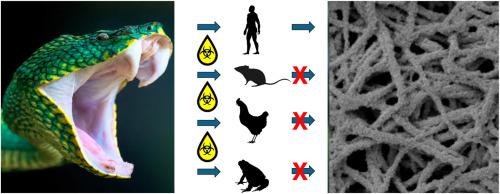环境导致凝块:人类和多种动物血浆中蛇毒凝血酶样酶诱导的纤维蛋白凝块形成的进化和翻译不匹配。
IF 2.4
4区 医学
Q2 PHARMACOLOGY & PHARMACY
引用次数: 0
摘要
蛇毒对猎物和被咬者的血液化学都产生动态影响。然而,确定人类和动物之间不同凝血毒性作用的比较测试,因此动物模型预测人类影响的适用性,是稀缺的。为了填补这一知识空白,本研究测试了具有凝血酶样毒液的pitviper如何在脊椎动物血浆中发挥作用,以及动物模型是否可以预测人类的结果。我们利用血小板弹性成像技术对人类、啮齿动物、鸟类和两栖动物的血浆进行了评估,包括尖齿Deinagkistrodon acutus, tsushimaensis, Ovophis okinensis, Protobothrops mangshanensis和Trimeresurus albolabris。测定定量起始、动力学和最大凝块强度。在人血浆中,所有的毒液都是凝血蛋白样的,以伪促凝剂的方式形成弱纤维蛋白凝块。在临床上,这将导致纤维蛋白原耗竭的净抗凝作用。然而,在动物血浆上的结果却明显不同。在人体血浆中产生强烈反应的测试剂量下,没有一种毒液在任何动物血浆中显示出类似凝血酶的活性。相反,有无数的其他活动表明纤维蛋白原的破坏性切割,凝血酶的抑制,以及凝血因子酶原的激活。这样看来,人类血浆中类似凝血酶的活性似乎是一种进化的生物产物,而不是猎物血浆中选择的产物。在这种情况下,动物模型并不能可靠地预测人类纤维蛋白原消耗蛇咬伤结果的机制基础。这强调了预测蛇咬伤结果的临床前测试的重要性,应该基于人类血浆测试而不是动物模型。这些结果强调了蛇毒研究如何从根本上处于进化生物学和毒理学的交叉点,单一的数据集对不同的研究领域有影响,但又相互关联。这些结果强调了一个范式,即动物模型通常不能很好地预测潜在的人类临床效应,反过来,对人体材料的影响也不能很好地预测潜在的猎物病理生理效应。本文章由计算机程序翻译,如有差异,请以英文原文为准。

Context makes the clot: Evolutionary and translational mismatches in snake venom thrombin-like enzyme-induced fibrin-clot formation between human and diverse animal plasmas
Snake venoms produce dynamic effects upon the blood chemistry of both prey species and human bite victims. However, comparative testing to ascertain differential coagulotoxic effects between humans and animals, and therefore the suitability of animal models to predict human effects, are scarce. To fill this knowledge gap, this study tested how pitviper with thrombin-like venoms act across vertebrate plasmas and whether animal models predict human outcomes. We evaluated Deinagkistrodon acutus, Gloydius tsushimaensis, Ovophis okinavensis, Protobothrops mangshanensis, and Trimeresurus albolabris using thromboelastography on human, rodent, avian, and amphibian plasmas. Assays quantified initiation, kinetics, and maximal clot strength. On human plasma, all venoms were thrombin-like, acting in a pseudo-procoagulant manner to form weak, transient fibrin clots. Clinically this would result in a net anticoagulant effect through fibrinogen depletion. However, the results on animal plasmas differed markedly. At the dose tested which produced a potent response in human plasma, none of the venoms displayed the thrombin-like activity on any animal plasma. Instead, there were a myriad of other strong activities suggesting destructive cleavage of fibrinogen, inhibition of clotting enzymes, and activation of clotting factor zymogens. As such, the potent thrombin-like activity on human plasma appears to be an evolutionary bioproduct, rather than one that is selected for prey plasma. Translationally in this case, the animal models did not reliably predict the mechanistic underpinnings of human fibrinogen-depleting snakebite outcomes. This emphasises the importance of preclinical testing of venom effects to predict snakebite coagulotoxic outcomes, which should be based upon human plasma testing rather than animal models. These results underscore how snake venom research is fundamentally at the intersection between evolutionary biology and toxicology, with a single data set having implications for diverse, yet interlocking, fields of research. These outcomes suggest that, for at least thrombin-like serine proteases, animal models in general are poor predictors of potential human clinical effects, and reciprocally that effects on human material are poor predictors of potential prey pathophysiological effects exerted by these toxic enzymes. Other coagulotoxic enzymes should be examined for similar discrepancies between animal and human plasmas, and consequently the utility of animal models as predictors of human clinical effects.
求助全文
通过发布文献求助,成功后即可免费获取论文全文。
去求助
来源期刊

Toxicon
医学-毒理学
CiteScore
4.80
自引率
10.70%
发文量
358
审稿时长
68 days
期刊介绍:
Toxicon has an open access mirror Toxicon: X, sharing the same aims and scope, editorial team, submission system and rigorous peer review. An introductory offer Toxicon: X - full waiver of the Open Access fee.
Toxicon''s "aims and scope" are to publish:
-articles containing the results of original research on problems related to toxins derived from animals, plants and microorganisms
-papers on novel findings related to the chemical, pharmacological, toxicological, and immunological properties of natural toxins
-molecular biological studies of toxins and other genes from poisonous and venomous organisms that advance understanding of the role or function of toxins
-clinical observations on poisoning and envenoming where a new therapeutic principle has been proposed or a decidedly superior clinical result has been obtained.
-material on the use of toxins as tools in studying biological processes and material on subjects related to venom and antivenom problems.
-articles on the translational application of toxins, for example as drugs and insecticides
-epidemiological studies on envenoming or poisoning, so long as they highlight a previously unrecognised medical problem or provide insight into the prevention or medical treatment of envenoming or poisoning. Retrospective surveys of hospital records, especially those lacking species identification, will not be considered for publication. Properly designed prospective community-based surveys are strongly encouraged.
-articles describing well-known activities of venoms, such as antibacterial, anticancer, and analgesic activities of arachnid venoms, without any attempt to define the mechanism of action or purify the active component, will not be considered for publication in Toxicon.
-review articles on problems related to toxinology.
To encourage the exchange of ideas, sections of the journal may be devoted to Short Communications, Letters to the Editor and activities of the affiliated societies.
 求助内容:
求助内容: 应助结果提醒方式:
应助结果提醒方式:


